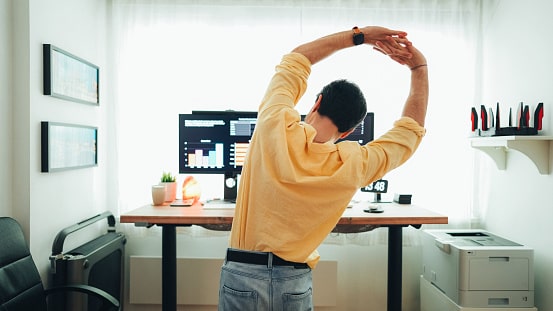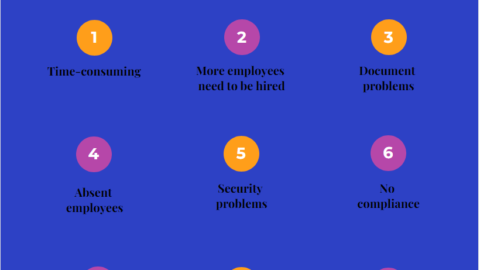Office Health & Safety: Why Does Ergonomic Furniture Matter?
In today’s fast-paced work environment, people often prioritise work over their health. However, this attitude can lead to a host of health issues that can negatively impact work performance and overall well-being. One solution to this problem is to incorporate ergonomic furniture in the office, as it plays a vital role in office health and safety.
Table of Contents
The 5 top health issues in an office environment
There are several health issues commonly associated with working in an office environment, which can have long-term consequences if left untreated.
1. Back strain & pain
One of the most prevalent issues is back strain and pain in regards to office health and safety matters. Office workers spend long hours sitting, often in chairs that do not support the back’s natural curvature. This prolonged sitting can lead to compression of spinal discs, leading to pain, stiffness, and a host of related problems.
2. Eye strain & fatigue

Eye strain and fatigue are also common issues. People who spend a significant amount of time staring at technology such as computer screens may experience dry eyes, blurred vision, and headaches. Over time, this can result in permanent damage to the eyes.
3. Carpal tunnel syndrome & repetitive strain injury
Carpal Tunnel Syndrome (CTS) is another health issue commonly associated with office work. It is a condition that results from repeated hand movements such as typing, which causes numbness, tingling, and pain in the fingers and hands. Repetitive Strain Injury (RSI) is another condition that can occur due to repeated actions such as typing, writing, and other office tasks. RSI can cause pain, numbness, and weakness in the affected area.
4. Neck & shoulder pain

Working in an office environment can be a risk factor for chronic neck and shoulder pain, as many people sit for long periods of time behind a desk, often without ergonomic support or proper posture. This can cause long term issues if the issue is not resolved which can lead to further, harder to prevent, discomfort.
4. Obesity & metabolic disorders
Obesity and metabolic disorders are also increasingly common health issues for office workers. Many people are at risk of gaining weight due to their sedentary work habits and it is a problem for office health and safety. Obesity can lead to several health issues such as high blood pressure, diabetes, and heart disease, all of which can negatively impact work productivity and longevity.
Ergonomic furniture & its role in office health & safety
Ergonomic furniture is beneficial for preventing health issues such as back pain, neck pain, and fatigue. It is designed to provide support and comfort for the user. It is adjustable to fit the individual’s body size, shape, and posture. This helps reduce stress on the body and minimises the risk of physical problems.
Adjustable and comfy furniture also helps reduce risk of carpal tunnel syndrome, which is caused by repetitive motions. Ergonomic furniture is also beneficial for people who sit for prolonged periods of time. It can help to maintain good posture at your office desk, reduce fatigue, and reduce the risk of developing musculoskeletal disorders such as back and neck pain.
Types of ergonomic furniture pieces include adjustable desks and chairs, ergonomic keyboards, mouse pads, and footrests. Adjustable desks and chairs can fit any individual’s body size and posture. Ergonomic keyboards may reduce strain on the wrists and hands. While mouse pads and footrests can help reduce fatigue by providing support.
Other ergonomic furniture pieces include standing desks, monitor risers, laptop stands, and lumbar support cushions. All of these pieces improve comfort, reduce strain, and improve posture. Ergonomic furniture can be a great way to prevent health issues and improve the overall comfort and productivity of any workspace.
Other ways to promote office health and safety

Besides ergonomic furniture, there are several other ways to promote health and safety in the workplace.
1. Workstation set up & design
One of the most effective ways is to encourage office health and safety with workstation setups that are specifically designed for each worker. A workstation that is customised to the user’s height, arm reach, and posture can significantly reduce the risk of injury and improve productivity.
2. Lighting & acoustics
Lighting and acoustics can be used to promote office health and safety. Proper lighting can reduce eye strain and fatigue, while strategic sound management can minimise distractions and reduce stress. For example, installing dimmable lighting can help reduce glare and improve visibility, while sound-absorbing materials can help reduce noise levels and echo.
3. Regular breaks & exercise
Taking regular breaks and engaging in physical activity during the workday can also be beneficial. Walking or stretching during breaks can help reduce stiffness and promote circulation, reducing the risk of pain and discomfort.
4. Healthy eating & hydration

In addition to physical activity, healthy eating and hydration can also help promote office health and safety. Drinking plenty of water throughout the day can help prevent dehydration, which can lead to headaches and other issues. Healthy snacks such as fresh fruit, vegetables, and nuts can also help keep workers energised and focused, reducing the risk of fatigue and sluggishness.
In conclusion, ergonomic furniture plays a crucial role in promoting health and safety in the workplace. By investing in ergonomic furniture, companies can help reduce the risk of injury and improve employee productivity and well-being. However, it is essential to remember that ergonomic furniture is just one piece of the puzzle.
Other factors, such as workstation design, lighting, physical activity, and healthy eating, are also important in promoting a safe and healthy work environment. By prioritising health and safety in the workplace, companies can help their employees stay healthy and productive, creating a better and more sustainable work culture.

Business Developmeny Manager at PAS InfoCom Technologies Ltd. Experienced in project management with a demonstrated history of working in the information technology and services industry.










